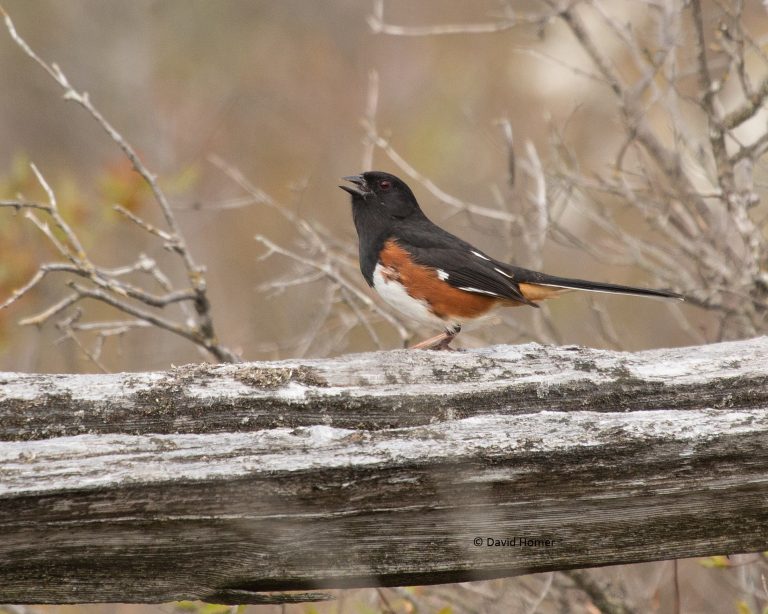It was one of those absolutely beautiful mid- week spring mornings. I had been watching and photographing a pair of Eastern Bluebirds from my car window while parked on the side of the road. On second thoughts, it wasn’t a road, but more like a trail with lots of holes filled with water. I had been watching the Bluebirds for about fifteen minutes and had lots of pictures, so I was thinking of moving on when I heard a noisy rustling of leaves in the undergrowth under the rail fence a few metres ahead. (Vehicles make for great, instantly transportable viewing blinds, obscuring the occupant from birds and animals which consider the human form a threat!)
I started the car and moved on to where the sound was coming. As it was so loud, I thought it must be a skunk or racoon still searching for dinner before heading off to sleep for the day; maybe even a dog or a fox. But I couldn’t see any animal moving in the undergrowth. After a minute or so listening and watching, the noise stopped and from out of the undergrowth, a male Eastern Towhee flew up to the rail fence, tipped his head up and began to sing his heart out….”drink your tea…drink your tea!” (That’s an English translation of his song, an imitation of it.)
Towhees are a large member of the sparrow family, and like the Song and Chipping sparrows that forage under our birds feeders, they use their feet together to hop and scrape the leaf litter away, picking up the uncovered insects, grubs and seeds they expose. In the process, they are very good at disturbing the quiet of the morning.
“After a minute or so listening and watching, the noise stopped and from out of the undergrowth, a male Eastern Towhee flew up to the rail fence, tipped his head up and began to sing his heart out….”drink your tea…drink your tea!”
Eastern Towhees and the western Spotted Towhee used to be classified as a single species known as the Rufous- sided Towhee. Recent research indicates that they are indeed separate species. Males and females are quite similar, but the female is duller in colouration. They return to the same location each year as they have great fidelity to the nest site. So remember where you saw one and return there the following year!
The cup-shaped nest is built in thickets and hedge rows at the edge of the forest, of leaves, twigs, hair and mosses. Four to six creamy coloured eggs are laid and are incubated by the female alone for 12-14 days. As the nest is built on the ground in the understory, the eggs and young are prone to predation by both animals and birds and the parasitic behaviour of Brown-headed cowbirds!
Both parents will feed the young until they fledge at about 10 days and for about a month following.
Eastern Towhees are monogamous and live quite solitary lives. Their days are filled searching for food and caring for young. The best way to find and see them is to sit quietly on the side of a road or fence row near thick brush and shrubs. Listen for the tell-tale sound of rustling leaves. Sooner or later they will come in to the open, but it may only be for a very short time, so don’t drift off to sleep!
David A. Homer is a volunteer and on the Board of Directors at The Couchiching Conservancy, a non-profit land trust dedicated to protect nature for future generations.

